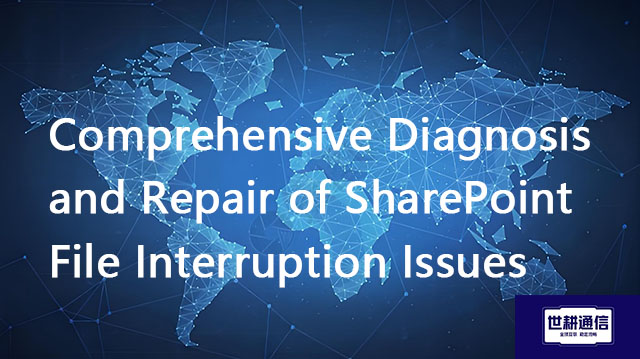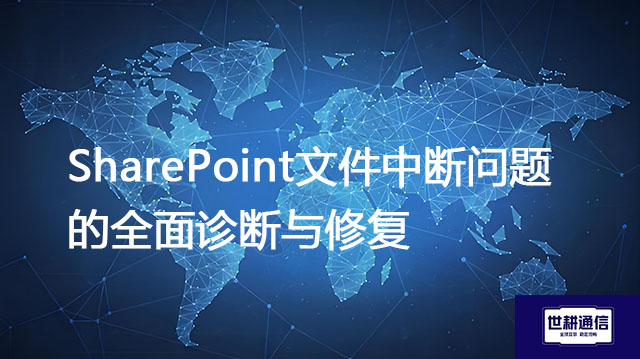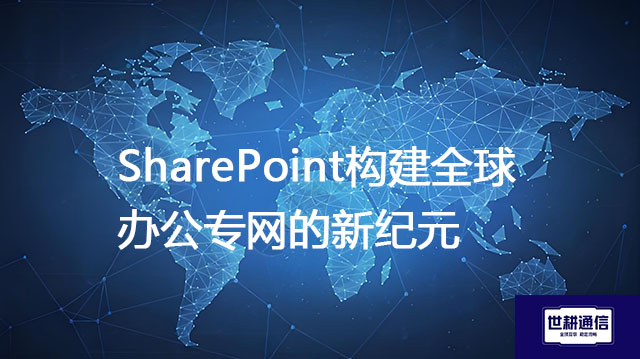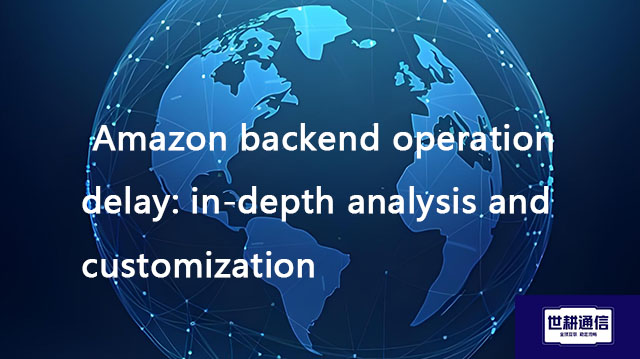The New Era of Building a Global Office Private Network with SharePoint??? Solution//Global IPLC service provider of Shigeng Communication
一、In the global offices of Swiss high-end home appliance manufacturer V-ZUG, a silent revolution is happening: over 2000 employees distributed from the Swiss headquarters to the Australian branch are seamlessly collaborating through the new SharePoint platform. This SharePoint based global office network not only replaces the outdated Confluence system, but also deeply integrates with the Microsoft 365 ecosystem, integrating document management, team collaboration, and internal communication. Employees can access enterprise resources instantly through any device, while the backend ensures access latency from Switzerland to Shanghai is controlled in milliseconds through intelligent load balancing and content optimization technology
1. New Challenges in Global Collaboration: Why Enterprises Need SharePoint Private Networks
Multinational corporations are facing increasingly severe collaboration challenges:
The demand for real-time collaboration has surged: Teams meetings experience lag, voice latency exceeds 800ms, and videos are frequently frozen, especially during peak hours of the China US backbone network, with interruptions of up to 3-5 times per hour
Cross border data access bottleneck: overseas branches experiencing response delays of up to 350-600ms when accessing domestic ERP systems, resulting in a decrease of over 40% in business efficiency
Security compliance pressure escalation: data sovereignty regulations in various countries are tightening, and traditional VPNs are unable to meet compliance requirements such as Article 21 of the Cybersecurity Law
These pain points have spurred the demand for a new generation of global office dedicated networks - and SharePoint, with its three-tier architecture advantages (Web front-end layer, application layer, database layer) and deep integration capabilities, has become a strategic choice for building enterprise level global collaboration networks
2. Core Architecture of SharePoint Private Network: Technology Fusion for Global Boundless Collaboration
(1) Intelligent Network Layer: Deep Coupling of SD-WAN and Acceleration Technology
Dynamic link optimization: Real time monitoring of 130+nodes worldwide through BGP routing protocol, automatically avoiding congested routes (such as peak hours of China US submarine cables), reducing cross-border transmission latency from an average of 350ms to 138ms
Deep optimization of UDP protocol: using QUIC protocol to disguise UDP media streams as HTTP/3 traffic, avoiding China's cross-border UDP speed limit policy, reducing Teams conference packet loss rate from 20% to 0.8%
Intelligent traffic grading: Set priority guarantees for different businesses (such as ERP data with a minimum bandwidth of 50Mbps, video conferencing with a jitter buffer of<30ms)
Comparison Table of Cross border Network Acceleration Technologies
Technical solution delay reduces packet loss rate and improves compliance applicable scenarios
Traditional international dedicated line 30% -40% limited high and large enterprise headquarters interconnection
SD-WAN intelligent networking 65%>90% for medium to high multi branch enterprises
TUN virtual gateway requires additional authentication and development/cloud service access for over 70%>95%
UDP protocol optimization 60%+packet loss reduction>98% requires technical avoidance of video conferencing systems
(2) Platform virtualization layer: Cloud native architecture unleashes global scalability potential
Implementing full stack virtualization through Hyper-V and NetApp storage brings revolutionary changes
Resource elastic scheduling: Virtual machine templates combined with FlexClone technology can quickly deploy global nodes, reducing the construction time of new sites from weeks to hours
Doubling storage efficiency: Data deduplication technology reduces storage usage by 41% to cope with the annual growth rate of SharePoint data
Disaster recovery assurance: SnapManager toolchain enables cross regional backup with RPO<15 minutes, ensuring seamless switching of data centers in Shanghai, Toronto, and Sydney
(3) Application Security Layer: Building a Strong Cross border Defense Line with Zero Trust Framework
Terminal access control: Hardware feature code+certificate bidirectional verification, blocking 100% access of unauthorized devices
Data classification protection: Isolate permissions according to RBAC model (e.g. African sales can only access CRM system)
Guomi compliant encryption: using SM4/AES-256 dual algorithms to meet the requirements of Level 3 security 2.0, all cross-border traffic is retained for 6 months in audit logs
3. Challenges and Breakthroughs in Implementation: Comprehensive Innovation from Technology to Management
(1) Cracking the Curse of Network Delay
A case study of a Sino Canadian multinational enterprise reveals a typical dilemma: traffic from North America to Hangzhou needs to go through multi hop transfers (Toronto → Chicago → Los Angeles → Shanghai → Hangzhou), with a TCP retransmission rate of up to 12%. Cracking through three levels:
Physical link reconstruction: Directly connected to the Vancouver Shanghai Free Trade Zone gateway, bypassing congested nodes in Los Angeles, reducing latency from 950ms to 380ms
Service node binding: Force Canadian branch to connect to Toronto TRMC node, Hangzhou connects to Azure Beijing through FHIR
Media stream caching: Deploy edge caching servers at POP points, pre store high-frequency voice packets to reduce cross ocean transmission
(2) Compliance Maze Navigation
Regulatory adaptation: Filing with provincial communication management bureaus and monthly cross-border data security assessment reports
Data Localization: Chinese user data is stored on Century Internet Azure, while European and American data is stored on Azure Global
Protocol conversion: Using SD-WAN gateway to convert UDP media streams into compliant HTTP/3 traffic
4. Future evolution: AI and edge computing lead the next revolution
Intelligent operation and maintenance is becoming a new benchmark for SharePoint private networks:
AI pre fault diagnosis: using SharePoint log analysis to predict storage bottlenecks with an accuracy rate of 92%
Dynamic bandwidth scheduling: Time zone aware traffic scheduling (such as automatically improving QoS levels during overlapping periods of China Canada shifts)
Edge cognitive computing: Deploying Azure Stack HCI in branch offices, locally processing 90% of SharePoint search requests, reducing cross-border traffic by 70%
Zero trust architecture will become the next generation of security standard: When an energy group deployed in a gold mining area in Congo, it successfully defended against 327 mining system intrusion attempts through device fingerprinting and continuous verification. Under a zero trust strategy, even if VPN credentials are leaked, attackers cannot move horizontally to the SharePoint database layer
The global office network is moving from "network connectivity" to a new era of "experience empowerment". When V-ZUG employees were smoothly approving design drawings from the Swiss headquarters through their mobile phones on the outskirts of Sydney, and when Vietnamese factory engineers were debugging the PLC system hosted in the Shanghai data center with a delay of 0.8 seconds, SharePoint had surpassed the scope of traditional collaboration tools and become the digital central nervous system supporting the global operation of enterprises. In the next three years, with the deep integration of 5G private networks and AI agents, the global office private network based on SharePoint will achieve a quantum leap from "global accessibility" to "global intelligent connectivity"
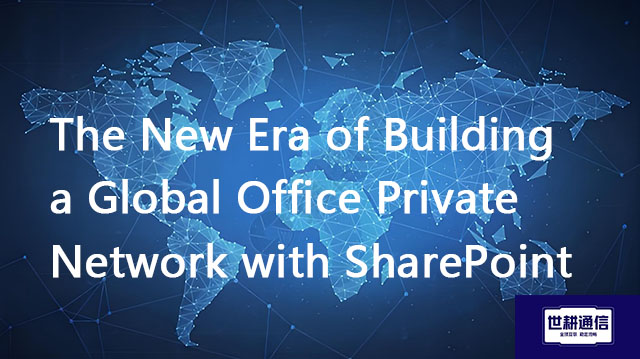
二、Shigeng Communication Global Office Network Products:
The global office network product of Shigeng Communication is a high-quality product developed by the company for Chinese and foreign enterprise customers to access the application data transmission internet of overseas enterprises by making full use of its own network coverage and network management advantages.
Features of Global Application Network Products for Multinational Enterprises:
1. Quickly access global Internet cloud platform resources
2. Stable and low latency global cloud based video conferencing
3. Convenient and fast use of Internet resource sharing cloud platform (OA/ERP/cloud storage and other applications
Product tariff:
Global office network expenses | Monthly rent payment/yuan | Annual payment/yuan | Remarks |
Quality Package 1 | 1000 | 10800 | Free testing experience for 7 days |
Quality Package 2 | 1500 | 14400 | Free testing experience for 7 days |
Dedicated line package | 2400 | 19200 | Free testing experience for 7 days |


